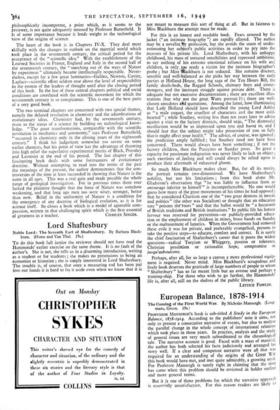Lord Shaftesbury
Noble Lord: The Seventh Earl of Shaftesbury. By Barbara Black- burn. (Home and Van Thal. 15s.) To do this book full justice the reviewer should not have read the Hammonds' earlier exercise on the same theme. It is no fault of the author's. She is not, she tells us in a disarming introduction, writing as a student or for students ; she makes no pretensions to being an economist or historian ; she is simply interested in Lord Shaftesbury. The trouble is, of course, that once a measuring rod has been put into our hands it is hard to lay it aside even when we know that it is
not meant to measure this sort of thing at all. But in fairness to Miss Blackburn the attempt must be made.
For this is an honest and readable book. Fears aroused by the jacket ("an intimate biography ") are rapidly allayed. The author may be a novelist.ty profession, but she avoids the snare of under- estimating her subject's public activities in order to pry into the recesses of his private life. Lord Shaftesbury, with his unhappy childhood, his mass of tortured sensibilities and repressed ambitions, to say nothing of his extreme emotional reliance on his wife and children, is only,t2o ready a victim for the intimate biographer's probe ; but Miss 1Mckburn is not seduced. She remains discreet, sensible and well-balanced as she picks her way between the early parties at Holland. House, the long saga of the Ten Hours Bill, the family death-beds, the Ragged Schools, chimney boys and coster- mongers, and the incessant struggle against private debt. There is adequate but not excessive documentation ; there are excellent illus- trations (but why not the great Watts portrait ?); there are well- chosen anecdotes slid quotations. Among the latter, how illuminating that Lady Holland should have described the young Lord Ashley as "a male coquet, the cruellest of characters and the most cold- hearted " ; while Southey, writing less than ten years later to advise against a visit to the factory districts, should urge, " The distressful recollection would be so impressed upon you and burnt in, and I should fear that the subject might take possession of you so fully that•it might affect your health." The advice, of course, was ignored ; the prediction amply fulfilled ; but Southey need not have been concerned. There would always have been something ; if not the factory children, then the Puseyites or Sunday posts. So great a capacity for passionate indignation was never likely to lack an object ; such exertions of .,feeling and will could always be relied upon to produce their aftermath of exhausted gloom.
So much Miss Blackburn makes clear. But, for all its merits, the portrait remains two-dimensional. We have Shaftesbury's nobility, but not his limitations ; from this book alone Mr. Gladstone's observation that "he was liable to influence from an entourage inferior to himself " is incomprehensible. No one would guess how many of the great movements of his times he had opposed ; that he considered Chartism one of the " two great demons in morals and politics " (the other was Socialism) or thought that an education rate " poisons thetoots " and that the ballot would be " a hecatomb of British traditiohs and British institutions." In public life his hottest fervour was reserved for prevention—or publicly-provided educa- tion or the employment of children in mines, brass bands on Sunday or the maltreatment of lunatics. When the Government had removed these evils it was for private, and preferably evangelical, persons to take the positive steps—to educate, comfort and correct. It is surely the chief fascination of Shaftesbury's career that it poses the widest questions—radical Toryism or Whiggery, passion or tolerance, Christian pessimism or rationalist hope, compromise or jusqu'auboutisme.
Perhaps, after all, for so large a canvas a more professional equip- ment is required. Never mind. Miss Blackburn's scrupulous and lively book deserves the gratitude of large numbers of people to whom " Shaftesbury" has so far meant little but an avenue and perhaps training-ship. For those who wish to go further, the Hammonds life is, after all, still on the shelves of the public library.
LErmE FOWLER-


































 Previous page
Previous page